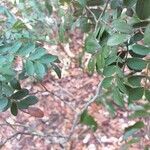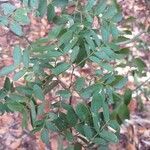A rather slender tree usually about 10 m in height, but reaching 15 m under favourable conditions. Bark: grey, smooth, powdery, later becoming darker, roughish, flaking and cracking into square sections. Leaves: with 3-7 pairs of opposite leaflets plus the terminal one; leaflets oblong to oblanceolate, 4-9 x 2-4.5 cm, dark green above, paler green below, young leaflets softly velvety, especially on the undersurface, becoming smooth by maturity, 4-6 pairs of lateral veins; apex and base tapering; margin entire; petiolules 2-5 mm long petiole 2-7 cm long. Flowers: pea-shaped, smallish, the standard petal magenta-purple to pale mauve, the stamens joined to form a yellow tube around the style; in attractive lax, pendant sprays 10-20 cm long, before the new leaves. Fruit: a pod, 4-10 x 1-1.5 cm, pale straw-coloured to light brown, hanging down in loose clusters, indehiscent, with 1-3 seeds.
Leaves imparipinnate, 12–25 cm long; petiole 2–7(8) cm long, rachis 6–12 cm long, pubescent, hairy or glabrous; petiolules 2–5 mm long; leaflets 7–13(15), opposite or subopposite, 2–7(11.5) × 1–3(5) cm, subcircular to ovate or elliptic or narrowly elliptic to narrowly obovate, rounded to obtuse or acute and sometimes emarginate at the apex, rounded or obtuse or cuneate to narrowed cuneate at the base, stiff, appressed-puberulous and glabrescent on upper surface, pubescent beneath at least on the main nerves; lateral nerves in 4–6 pairs; reticulation somewhat prominent or flat beneath; stipules linear, 3–6 mm long, caducous; stipels 1–3 mm long or absent.
Standard 9–15 mm long, blade broadly obovate, subcordate with small inflexed auricle, claw 2 mm long; wings 11–11.5 × 4 mm, rounded at the apex, auricle acute, claw 2.5 mm long; keel petals 10–14 × 4.5–5.5 mm, auricle acute, claw 3 mm long.
Inflorescence a ± flexuose panicle 8–35(40) cm long, usually borne precociously at the top of last season’s branches (occasionally 2–3 together), rarely terminal, fulvous-puberulous or glabrous; bracts and bracteoles falling early.
Pod 1–2(4)-seeded, 6–12(14) × 1.2–2.8 cm, 1-seeded pods elliptic, 2-seeded pods linear, glabrous, stiff, apex rounded or obtuse or acute, base obtuse to cuneate; stipe 4–6 mm long.
Calyx 4–5 mm long, thinly fulvous-silky, upper tooth-pair 2.5 mm long, bilobed or entire, the lateral ones 1–1.5 mm long, rounded or obtuse, the lower one 1.5–2 mm long, acute.
Ovary 4–6-ovulate, shortly stipitate, puberulous; style 1.5–2 mm long, glabrous.
Branchlets fulvous-pubescent, hairy or glabrous; bark dark grey to red-brown.
Ripe seed 10–12 × 7–8 mm, flattened, reniform, dark red-brown.
Stamens connate in a tube, the upper stamen free at the base.
Tree up to 12 m tall; crown spreading; bark brown.
Flowers 10–12 mm long; pedicels 2–6 mm long.


